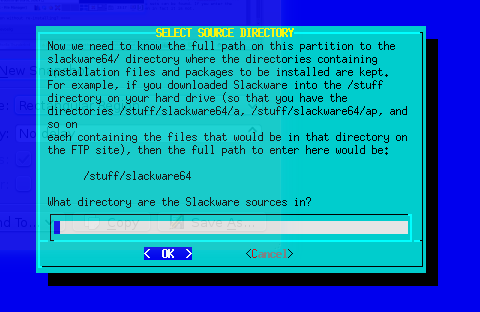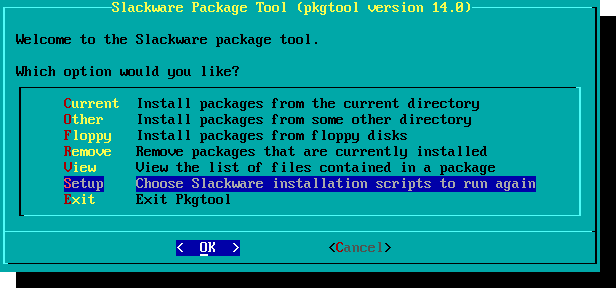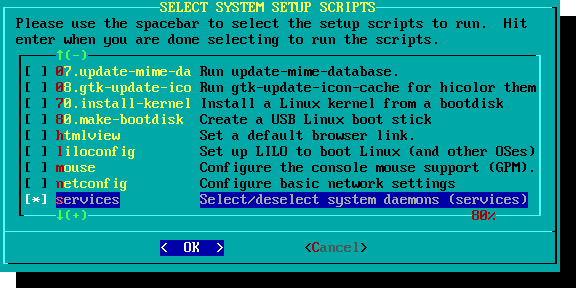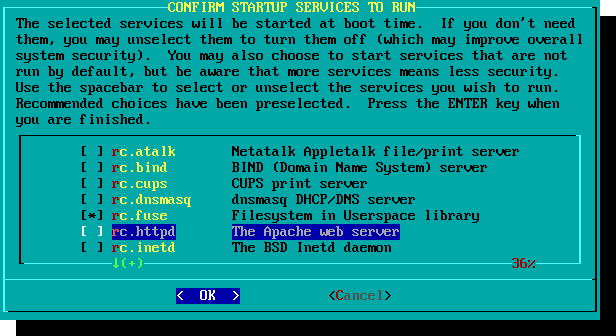Зміст
Часті запитання
Вступ
Цей документ відповідає на часті питання по Slackware Linux. Якщо ви маєте запитання, ви можете створити в заголовку новий розділ, та нижче під запитанням залишити відповідь. Якщо ви не можете знайти відповідь на своє питання, залиште його без відповіді, хтось інший може дописати відповідь. Таким чином, “часті запитання” може стати гарним містом для зберігання нотаток в стилі питання-відповідь, особливо якщо питання не вартує окремої статті, але є дуже важливим.
Якщо відповідь дуже довга, щоб її розділяти на два пункту, просто додайте посилання на відповідь (на вже існуючю сторінку), чи створіть нову строінку (якщо такої ще немає), та опишіть як вирішати таке складне питання, в окремій статті.
Основні по Slackware
Що таке Slackware Linux?
Дивіться сторінку Slackware Linux.
Як я можу отримати копію Slackware Linux?
Отримати Slackware Linux можна безкоштовно завантаживши образ диску, напряму з інтернет(FTP), дзеркал в інтернеті та через BitTorrents .
Чи можу я купити копію Slackware Linux?
Авжеж, просто перейдіть до крамниці Slackware.
Чи можу я купити одяг з логотипом Slackware?
Так, просто загляньте до крамниці Slackware.
Навіщо тратити гроші, якщо я можу безкоштовно завантажити Slackware з інтернету?
Дійсно, Slackware Linux буде завжди вільно доступна для завантаження, без будь-яких додаткових умов. Але, майте на увазі: Slackware Linux розробляється Патріком Фолкердінгом (Patrick Volkerding) в режимі повного робочого дня. Продаж дисків CD, DVD та інша атрибутика зі Slackware, є єдиним джерелом заробітку для цієї системи. Основна команда розробників працюють з Патріком, вони не отримують за це заробітну плату, але якщо Патрік зупинить розробку, тому що не зможе далі розробляти систему тільки на свої кошти, в цьому випадку дистрибутив спіткає невизначене майбутнє.
Що за люди стоять за Slackware Linux?
Патрік Фолкердінг (Patrick Volkerding) засновник, керівний проектом та основний розробник Slackware. Його ще знають як (Великодушний диктатор життя) (BDFL (Benevolent Dictator for Life)). Ще є декілька активних розробників які допомагають Патріку супроводжувати дистрибутив.
Нещодавно LinuxQuestions.org взяв інтерв'ю у Патріка Фолкердінга. Це інтерв'ю покриває багато закулісної роботи, включаючи спогади про колишніх та теперішніх розробників/помічників, їхня поміч, та коротка історія Slackware Linux.
В тому числі серед поточних помічників є Ерік Емілірс (Eric Hameleers) (знайомий як AlienBOB), Робі Воркмен (Robby Workman) (з.як rworkman), Стюарт Вінтер (Stuart Winter) (з.як MoZes), Ерік Ян Тромп (Eric Jan Tromp) (з.як alphageek), Алан Хікс (Alan Hicks), Марк Пост (Mark Post), Фред Емот (Fred Emmott), Вінцент Батс (Vincent Batts), Хенз Вісенжер (Heinz Wiesinger) (з.як pprkut) та багато інших.
Що це за розмови про стабільну (stable) та current версії?
За звичай Slackware поставляється двох типів: stable та “current”.
Стабільна версія випусків має номера (12, 12.1, 13, 13.37, 14.0, 14.1 та далі.). Вони підтримуються декілька років після виходу, методом випуску виправлень безпеки. Оновлення безпеки додають до піддиректорії /patches/packages/“ дерева Slackware на будь-якому дзеркалі в інтернеті. Створення додаткового функціоналу після випуску нової версії, не робиться. Гілка “current” це гілка для розробки яка завжди є окремою від дерева поточного стабільного випуску Slackware. Зазвичай розділення дерева на дві частини, виконується через декілька тижнів після виходу нового випуску.
Ця процедура відмічає момент, початку нового циклу розробки наступного (next) стабільного випуску. Наприкінці циклу розробки, створюється випуск Slackware шляхом перейменування головної директорії ”slackware-current“ на ”slackware-NEWVERSION“. Slackware-current як відомо, відносно часто оновлюється і ці оновлення є потенційно небезпечними для стабільності системи. Новачки та користувачі які шукають стабільну систему для промислового використання, повинні завжди використовувати (найсвіжіший) стабільний випуск. Розробники Slackware припускають, що користувачі slackware-current розуміють, що він/вона є по суті бета тестером.
To sum it up:
- Stable is built on rock-solid components, with well tested software. This recommended version will fit your desktop or server needs.
- Current is the testing ground for the upcoming release. The software you will find there will often be upstream's latest version. For more information on current, please visit the dedicated page.
If you want to know when the next version will be released (at time of writing the most recent stable release is 14.1), it will be ready… when it's ready! There are no fixed release dates, as the Slackware goal is to deliver the most stable Linux experience.
Installation and Support
How can I verify my copy of Slackware Linux?
All files in a Slackware Linux distribution can be verified against the GPG key of the distribution. For instance, if you want to verify if the ISO image you downloaded is an official¸ non-modified ISO image, then you run the following sequence of commands (example ISO for Slackware 13.37 for x86_64 platform):
$ wget http://slackware.com/gpg-key ... 2012-08-25 20:04:01 (81.3 MB/s) - ‘gpg-key’ saved [1357/1357] $ gpg --import gpg-key gpg: key 40102233: public key "Slackware Linux Project <security@slackware.com>" imported gpg: Total number processed: 1 gpg: imported: 1 $ gpg --verify slackware64-13.37-iso/slackware64-13.37-install-dvd.iso.asc gpg: Signature made Mon 25 Apr 2011 07:14:02 PM CEST using DSA key ID 40102233 gpg: Good signature from "Slackware Linux Project <security@slackware.com>"
This message (gpg: Good signature) means that the ISO file is the same file which was cryptographically signed by Patrick Volkerding.
How do I install Slackware Linux?
Read the installation guide.
During network installation I only see the "A" package series
You are attempting an installation of Slackware from a HTTP or FTP server. After entering the server's hostname and the Slackware package directory, you see the usual messages like ”INITIALIZING PACKAGE TREE“, but then during the ”PACKAGE SERIES SELECTION“, you can only select ”A - BASE LINUX SYSTEM“. Where are all the other package series?
You will experience this scenario when you are using a 32-bit bootable installer image to install a 64-bit Slackware from a webserver, or vice versa 1): you attempt an installation of 32-bit Slackware using a 64-bit installation image.
Solution: use the same architecture for the installer image and for the architecture of the Slackware release that you want to install from a webserver.
The package installation took 3 seconds and now what?
Installing more than 1000 packages should take between 10 and 45 minutes, depending on the computer you are installing them on. If the installer claims it is finished after only a few seconds, that means it did in fact not install anything at all. So what happened here?
This kind of issue occurs when you are not installing from the DVD or CD you booted from, but selected one of the alternative installation methods: a pre-mounted directory, or a loop-mounted ISO, etcetera. In all those cases, you have to enter a directory path to the location where the subdirectories representing the Slackware package sets can be found (the 'a', 'ap', 'd', …, 'y' directories).
If you enter the wrong directory there, then the installer will not complain about your error. It will pretend that it installs packages when in fact it is not. Look at this message closely:

How do I upgrade an existing Slackware Linux installation without re-installing?
Read the page on Slackpkg, particularly the full system upgrade section.
To track the “Current” branch, read the page on Slackware-Current.
If you wish to perform a major upgrade from an earlier release to the latest stable version, you should read and follow the instructions in UPGRADE.TXT and CHANGES_AND_HINTS.TXT files provided in the official Slackware CD/DVD or internet mirror for the appropriate version (that is, the latest version).
Where do I get more information on Slackware Linux online?
A bunch of links to valuable online sources of Slackware information can be found on this page. The officially recognized web forum for the Slackware community is at LinuxQuestions.org forums.
Where can I find commercial support for Slackware Linux?
The official Slackware website lists some companies which offer Slackware Linux technical support and consulting. It is probably better to make local inquiries in your city or town for Linux related tech services if you need hands-on support. The local LUG (Linux User Group) might also prove to be a valuable source of advice/information.
Does Slackware Linux have a special "desktop" edition, "server" edition and...
No, there is only one edition of Slackware. Slackware is a general purpose distribution that can be configured and customized to the end user's needs. See also the Slackware philosophy for a lengthier explanation for adhering to the KISS philosophy.
When will Slackware Linux "x.y" version be released?
Slackware Linux does not have a fixed release schedule. The principle behind this is to release when ready and not before. There are no six-month release cycles like a few other popular Linux distributions. See the philosophy page for more information.
Does Slackware Linux work with my hardware or peripheral?
In short, if the Linux kernel supports a piece of hardware, so does Slackware. The distribution's “huge” kernel is compiled with maximum support for most devices and is a pristine, unpatched kernel. So if any Linux distribution is likely to have support for a given hardware device, Slackware should.
Be aware that, even if a device is supported by a kernel driver, end user applications and userspace tools to utilize the full functionality of the hardware may be lacking. This is a rather complex topic and may require persistence and patience to research and figure out, especially in the case of low-cost or obscure devices.
Use an Internet search engine such as Google or DuckDuckGo, or use a community contributed hardware compatibility list like the LinuxQuestions HCL to find out if your piece of hardware works on Linux or not.
While this can be a considerably daunting task for new Linux users, here are some references to get started:
- For printers, CUPS and OpenPrinting.org are good sources to look for device compatibility.
HP printers and MFDs (Multi-Function Devices) have their own open source drivers at HPLIP. - For supported scanners, take a look at the SANE project.
- For webcams, and USB video class devices, Linux UVC drivers & tools can help.
- Linux supports several models of Wacom pen tablets and devices. See the linuxwacom project for more information. Many non-wacom tablets are supported by the Wizardpen driver.
Software and Package Management
How do I install/upgrade/remove software in Slackware Linux?
Slackware Linux comes with its own package management tools, namely pkgtool, installpkg, upgradepkg and removepkg for installing, upgrading and removing software packages. makepkg can be used to create packages. See also slackpkg and the page on installing software.
Why doesn't Slackware Linux have my favourite "XYZ" software included in the CD/DVD?
The official distribution is small enough for various reasons, the most important one being constraints on developers' time and resources. The short answer is that the official Slackware distribution cannot carry every possible open source application that might be needed by its users. However, Slackware still provides a large number of applications that are needed by most users.
Other sources for obtaining software not found in the Slackware CD/DVD (both in source and binary form):
- There are quite a few trusted and well-respected individual Slackware contributors who make their SlackBuild scripts and binary packages available online. One source is AlienBOB's repository and another is Robby Workman's packages.
- SlackBuilds.org is a community source of high quality and tested build scripts that make it easy to install third-party software on Slackware, and sbopkg, makes processing SlackBuilds easier.
- Another option is to use binary packages from Slacky.eu or other binary Slackware package sources. Note that packages are contributed by the community and the quality of packaging may vary from person to person.
- Still another option is to convert rpm packages to Slackware packages by using the tool rpm2tgz.
- Last but not the least, intermediate to advanced users generally prefer to compile from upstream sources or write their own SlackBuild scripts.
Why doesn't Slackware's package manager do dependency handling?
This is a huge debate in the Open Source community, bordering on vi vs emacs like flame wars, in reference to package management and dependency handling; but for several reasons, summarized shortly below, Slackware does not prefer ”automagic“ dependency resolution:
- Automatic dependency handling requires constant manual developer maintenance, and adds potential for dependency hell.
- The official Slackware Linux distribution is anyway meant to act as a cohesive whole. Hence, dependency management is largely moot as installing the entire distribution (the recommended way) takes care of most dependency problems.
- Several popular Open Source applications can be compiled with different dependencies based on compile-time configuration switches. This makes dependency handling harder and more error-prone for binary redistribution of third party software.
- Slackware Linux official distribution does not have the resources or manpower to manage dependency handling for third party software, which is a complex undertaking, requiring a lot of testing and is prone to errors as already noted above.
However, there are still solutions for third-party software automatic dependency handling for those who want it. slapt-get is a package manager that adds dependency handling for third party package sources like LinuxPackages.net and Slacky.eu.
Salix OS is a Slackware derived distribution that incorporates dependency handling.
Distro X and Y does package management with dependency handling and...
Yes, many distributions have package managers that do dependency handling and do them well. Indeed, there are many choices in that regard. The Linux community still needs a stable, tried and tested distribution that doesn't. Slackware certainly fills a niche in the Linux community in that regard. But as always, preferences vary and many Linux users do prefer the bare simplicity of Slackware. One thing to bear in mind is that the core simplicity of the package management in Slackware has one significant side benefit: there will always be third-party enhancements and solutions to commonly faced issues.
Some may call it a bug, others may call it a feature. Be it so, Slackware remains committed to its core principles and this issue is one aspect of its core principles.
Miscellaneous
Why does Slackware take so long to boot up?
By default, Slackware installs the huge kernel, which has built-in support for all possible hardware drivers. This may increase you boot time as the kernel probes for hardware at startup. You can switch to the generic kernel by following the instructions in the file /boot/README.initrd. See also: how to set up the generic kernel.
You may also want to disable unused services in /etc/rc.d/ directory by disabling the executable bit of the startup script. For instance, to disable the Apache daemon, simply run (as root)
chmod -x rc.httpd
If you prefer screen menus to do same task you can run (as root) pkgtool
# pkgtool
navigate to Setup item and press Enter
 then navigate to
then navigate to services item, mark it with Space key and press Enter
 then clear mark in front of
then clear mark in front of [ ] httpd item with Space key and press Enter.
 Finally, select
Finally, select Exit end press Enter.
Additionally, if you use LILO, Slackware's default boot loader, you can add the compact option to /etc/lilo.conf to speed up the boot process by merging read requests from adjacent sectors:
# LILO configuration file # generated by 'liloconfig' # # Start LILO global section # Append any additional kernel parameters: append=" vt.default_utf8=1" boot = /dev/sda compact
Also, Slackware runs a bunch of X/GTK related scripts at startup for multiuser runlevels (fc-cache, update-mime-database, gtk-update-icon-cache, update-gtk-immodules, update-gdk-pixbuf-loaders , update-pango-querymodules etc.). These may be disabled manually by commenting out those lines which refer to them in the file /etc/rc.M but don't disable anything unless you're absolutely sure you know what you are doing! These scripts are essential for GTK applications to render fonts and icons properly.
Slackware Linux has a reputation for being tough for newbies. Is this true?
Read The Slackware way to find out what you can expect from a distribution like Slackware. While Slackware certainly is different from many other distributions, whether easy or difficult to use is a matter to be decided entirely by the individual user.
Some things to bear in mind, though:
- Slackware has a text-menu based (ncurses) installer and requires several technical decisions to be made at install-time, some of which can be potentially destructive to the data on the hard disk. In other words, when in doubt, don't perform any potentially destructive actions and do consult the help documentation.
- A new Slackware installation initially boots into a text console by default and can be configured to boot into a GUI later, as opposed to desktop-based distributions that boot into a GUI login screen by default.
- Basic knowledge of standard shell (bash) commands and a text-mode editor such as vim is necessary to start using Slackware comfortably.
- Some knowledge of the locations of commonly used configuration files and scripts found in *nix-like systems would make things much more comfortable.
